Kodaly – Dances of Galanta
By Jeff Counts
Instrumentation: 2 flutes (2nd doubles piccolo), 2 oboes, 2 clarinets, 2 bassoons, 4 horns, 2 trumpets, timpani, glockenspiel, snare drum, triangle, strings.
Duration: 16 minutes in five sections.
THE COMPOSER – ZOLTÁN KODÁLY (1882-1967) – The 1930s provided interesting commission opportunities for Kodály. Many were related to anniversaries. During the decade, the Concertbebouw and the Chicago Symphony would both celebrate their 50th and the Budapest Philharmonic Society would have its 80th. The latter engaged the composer to compose a commemorative work in 1933, and Kodály, the pre-eminent folk scholar and proud native son, had plenty of material to bring to the project.
THE MUSIC – The Slovakian town of Galanta, where Zoltán Kodály spent several years as a child, was once part of Hungary. Kodály always spoke fondly of his Galanta days and owed much of his adult devotion to folk song collecting to the formative musical experiences he had there. An important element of the city’s cultural legacy was the town band, led in Kodály’s youth by a fiddle player named Mihók. Though not yet obvious to Kodály as a youngster, Mihók and his fellow musicians were part of a long-standing source of civic pride in Galanta. As famous as Mihók was in his own right, Kodály would later learn that the notoriety he enjoyed was based in part on a century-old custom. It had been preserved in a large collection of old Hungarian dances (published in Vienna around 1800) that quoted the Galanta Gypsy tradition as a primary source. These legendary dances, paired with the sounds of Mihók’s more modern Galanta band formed the DNA of Kodály’s 1933 tribute to his adopted hometown. Most of the material Kodály chose for the Dances of Galanta was reconstructed in the Verbunkos style. Verbunkos was originally a form of military recruiting music meant to entice young males to enlist in the army but it became an important 19th century Hungarian folk standard, one also occasionally referred to in the music of Kodály’s compatriot Béla Bartók. Kodály handled the conducting duties himself at the premiere in 1934.
THE WORLD – Japan left the League of Nations in 1933, the same year Hitler was proclaimed Chancellor of Germany. Also in 1933, aviator Wiley Post became the first person to fly solo around the world and the film King Kong was released.
THE CONNECTION – Dances of Galanta last appeared on the Utah Symphony Masterworks series in 2009. Keith Lockhart conducted.











